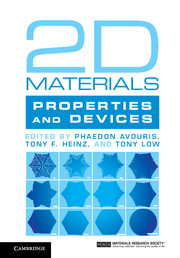Crossref Citations
This Book has been
cited by the following publications. This list is generated based on data provided by Crossref.
Liang, Jing
Zhang, Jin
Li, Zhenzhu
Hong, Hao
Wang, Jinhuan
Zhang, Zhihong
Zhou, Xu
Qiao, Ruixi
Xu, Jiyu
Gao, Peng
Liu, Zhirong
Liu, Zhongfan
Sun, Zhipei
Meng, Sheng
Liu, Kaihui
and
Yu, Dapeng
2017.
Monitoring Local Strain Vector in Atomic-Layered MoSe2 by Second-Harmonic Generation.
Nano Letters,
Vol. 17,
Issue. 12,
p.
7539.
de Sousa, D. J. P.
de Castro, L. V.
da Costa, D. R.
Pereira, J. Milton
and
Low, Tony
2017.
Multilayered black phosphorus: From a tight-binding to a continuum description.
Physical Review B,
Vol. 96,
Issue. 15,
Churchill, Hugh O. H.
Salamo, Gregory J.
Yu, Shui-Qing
Hironaka, Takayuki
Hu, Xian
Stacy, Jeb
and
Shih, Ishiang
2017.
Toward Single Atom Chains with Exfoliated Tellurium.
Nanoscale Research Letters,
Vol. 12,
Issue. 1,
Chen, Pengfei
Li, Neng
Chen, Xingzhu
Ong, Wee-Jun
and
Zhao, Xiujian
2017.
The rising star of 2D black phosphorus beyond graphene: synthesis, properties and electronic applications.
2D Materials,
Vol. 5,
Issue. 1,
p.
014002.
Low, Tony
and
Nemilentsau, Andrei
2018.
Manipulating Light with 2D Materials.
p.
1.
Li, Xuefei
Li, Tiaoyang
Zhang, Zhenfeng
Xiong, Xiong
Li, Sichao
and
Wu, Yanqing
2018.
Tunable Low-Frequency Noise in Dual-Gate MoS2Transistors.
IEEE Electron Device Letters,
Vol. 39,
Issue. 1,
p.
131.
Wilson, Josh
Santosa, Fadil
Min, Misun
and
Low, Tony
2018.
Temporal control of graphene plasmons.
Physical Review B,
Vol. 98,
Issue. 8,
Özçelik, V. Ongun
Fathi, Mohammad
Azadani, Javad G.
and
Low, Tony
2018.
Tin monochalcogenide heterostructures as mechanically rigid infrared band gap semiconductors.
Physical Review Materials,
Vol. 2,
Issue. 5,
Ratnikov, P V
and
Silin, A P
2018.
Two-dimensional graphene electronics: current status and prospects.
Physics-Uspekhi,
Vol. 61,
Issue. 12,
p.
1139.
Hao, Qi
Pang, Jinbo
Zhang, Yang
Wang, Jiawei
Ma, Libo
and
Schmidt, Oliver G.
2018.
Boosting the Photoluminescence of Monolayer MoS2 on High‐Density Nanodimer Arrays with Sub‐10 nm Gap.
Advanced Optical Materials,
Vol. 6,
Issue. 2,
Lee, In-Ho
Martin-Moreno, Luis
Mohr, Daniel A.
Khaliji, Kaveh
Low, Tony
and
Oh, Sang-Hyun
2018.
Anisotropic Acoustic Plasmons in Black Phosphorus.
ACS Photonics,
Vol. 5,
Issue. 6,
p.
2208.
Chaves, A.
Azadani, J. G.
Özçelik, V. Ongun
Grassi, R.
and
Low, T.
2018.
Electrical control of excitons in van der Waals heterostructures with type-II band alignment.
Physical Review B,
Vol. 98,
Issue. 12,
Khorasani, Sina
2018.
Third-Order Optical Nonlinearity in Two-Dimensional Transition Metal Dichalcogenides.
Communications in Theoretical Physics,
Vol. 70,
Issue. 3,
p.
344.
Liu, Yanpeng
Yudhistira, Indra
Yang, Ming
Laksono, Evan
Luo, Yong Zheng
Chen, Jianyi
Lu, Junpeng
Feng, Yuan Ping
Adam, Shaffique
and
Loh, Kian Ping
2018.
Phonon-Mediated Colossal Magnetoresistance in Graphene/Black Phosphorus Heterostructures.
Nano Letters,
Vol. 18,
Issue. 6,
p.
3377.
Paillet, Matthieu
Parret, Romain
Sauvajol, Jean‐Louis
and
Colomban, Philippe
2018.
Graphene and related 2D materials: An overview of the Raman studies.
Journal of Raman Spectroscopy,
Vol. 49,
Issue. 1,
p.
8.
Brar, Victor W.
Sherrott, Michelle C.
and
Jariwala, Deep
2018.
Emerging photonic architectures in two-dimensional opto-electronics.
Chemical Society Reviews,
Vol. 47,
Issue. 17,
p.
6824.
Biswas, Sudipta Romen
Gutiérrez, Cristian E.
Nemilentsau, Andrei
Lee, In-Ho
Oh, Sang-Hyun
Avouris, Phaedon
and
Low, Tony
2018.
Tunable Graphene Metasurface Reflectarray for Cloaking, Illusion, and Focusing.
Physical Review Applied,
Vol. 9,
Issue. 3,
Barraza-Lopez, Salvador
Kaloni, Thaneshwor P.
Poudel, Shiva P.
and
Kumar, Pradeep
2018.
Tuning the ferroelectric-to-paraelectric transition temperature and dipole orientation of group-IV monochalcogenide monolayers.
Physical Review B,
Vol. 97,
Issue. 2,
Maier, Matthias
Nemilentsau, Andrei
Low, Tony
and
Luskin, Mitchell
2018.
Ultracompact Amplitude Modulator by Coupling Hyperbolic Polaritons over a Graphene-Covered Gap.
ACS Photonics,
Vol. 5,
Issue. 2,
p.
544.
Tiouitchi, Ghassane
Raji, Marya
Mounkachi, Omar
Ali, Mustapha Ait
Mahmoud, Abdelfattah
Boschini, Frederic
Essabir, Hamid
Bouhfid, Rachid
and
Qaiss, Abou el kacem
2019.
Black phosphorus-based polyvinylidene fluoride nanocomposites: Synthesis, processing and characterization.
Composites Part B: Engineering,
Vol. 175,
Issue. ,
p.
107165.



